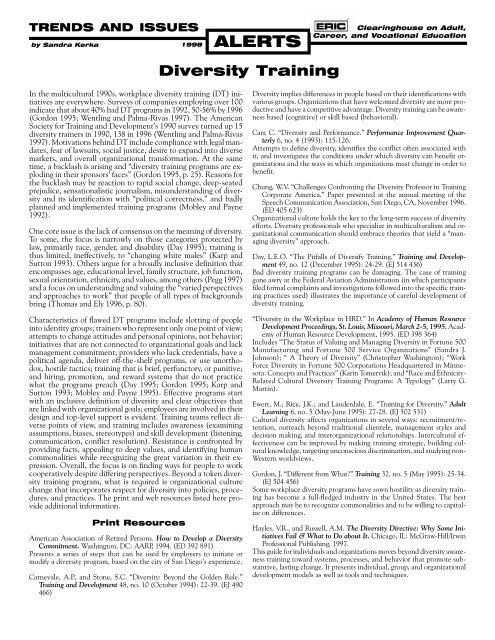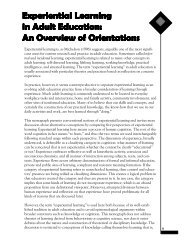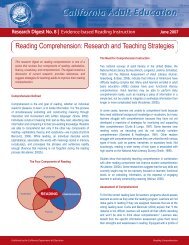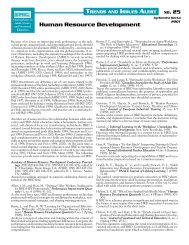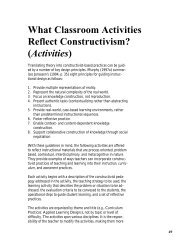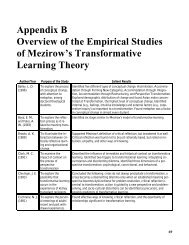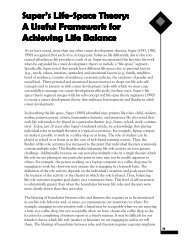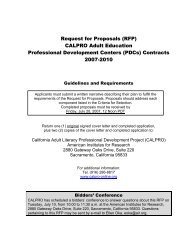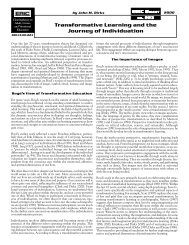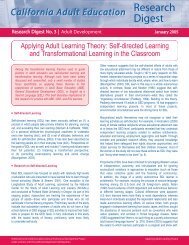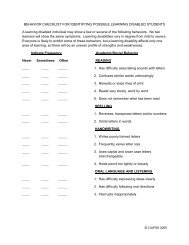ALERTS - CALPRO
ALERTS - CALPRO
ALERTS - CALPRO
Create successful ePaper yourself
Turn your PDF publications into a flip-book with our unique Google optimized e-Paper software.
TRENDS AND ISSUESby Sandra Kerka1998 <strong>ALERTS</strong>Clearinghouse on Adult,Career, and Vocational EducationDiversity TrainingIn the multicultural 1990s, workplace diversity training (DT) initiativesare everywhere. Surveys of companies employing over 100indicate that about 40% had DT programs in 1992, 50-56% by 1996(Gordon 1995; Wentling and Palma-Rivas 1997). The AmericanSociety for Training and Development’s 1990 survey turned up 15diversity trainers in 1990, 138 in 1996 (Wentling and Palma-Rivas1997). Motivations behind DT include compliance with legal mandates,fear of lawsuits, social justice, desire to expand into diversemarkets, and overall organizational transformation. At the sametime, a backlash is arising and “diversity training programs are explodingin their sponsors’ faces” (Gordon 1995, p. 25). Reasons forthe backlash may be reaction to rapid social change, deep-seatedprejudice, sensationalistic journalism, misunderstanding of diversityand its identification with “political correctness,” and badlyplanned and implemented training programs (Mobley and Payne1992).One core issue is the lack of consensus on the meaning of diversity.To some, the focus is narrowly on those categories protected bylaw, primarily race, gender, and disability (Day 1995); training isthus limited, ineffectively, to “changing white males” (Karp andSutton 1993). Others argue for a broadly inclusive definition thatencompasses age, educational level, family structure, job function,sexual orientation, ethnicity, and values, among others (Pegg 1997)and a focus on understanding and valuing the “varied perspectivesand approaches to work” that people of all types of backgroundsbring (Thomas and Ely 1996, p. 80).Characteristics of flawed DT programs include slotting of peopleinto identity groups; trainers who represent only one point of view;attempts to change attitudes and personal opinions, not behavior;initiatives that are not connected to organizational goals and lackmanagement commitment; providers who lack credentials, have apolitical agenda, deliver off-the-shelf programs, or use unorthodox,hostile tactics; training that is brief, perfunctory, or punitive;and hiring, promotion, and reward systems that do not practicewhat the programs preach (Day 1995; Gordon 1995; Karp andSutton 1993; Mobley and Payne 1995). Effective programs startwith an inclusive definition of diversity and clear objectives thatare linked with organizational goals; employees are involved in theirdesign and top-level support is evident. Training teams reflect diversepoints of view, and training includes awareness (examiningassumptions, biases, stereotypes) and skill development (listening,communication, conflict resolution). Resistance is confronted byproviding facts, appealing to deep values, and identifying humancommonalities while recognizing the great variation in their expression.Overall, the focus is on finding ways for people to workcooperatively despite differing perspectives. Beyond a token diversitytraining program, what is required is organizational culturechange that incorporates respect for diversity into policies, procedures,and practices. The print and web resources listed here provideadditional information.Print ResourcesAmerican Association of Retired Persons. How to Develop a DiversityCommitment. Washington, DC: AARP, 1994. (ED 392 891)Presents a series of steps that can be used by employers to initiate ormodify a diversity program, based on the city of San Diego’s experience.Carnevale, A.P., and Stone, S.C. “Diversity: Beyond the Golden Rule.”Training and Development 48, no. 10 (October 1994): 22-39. (EJ 490466)Diversity implies differences in people based on their identifications withvarious groups. Organizations that have welcomed diversity are more productiveand have a competitive advantage. Diversity training can be awarenessbased (cognitive) or skill based (behavioral).Carr, C. “Diversity and Performance.” Performance Improvement Quarterly6, no. 4 (1993): 115-126.Attempts to define diversity, identifies the conflict often associated withit, and investigates the conditions under which diversity can benefit organizationsand the ways in which organizations must change in order tobenefit.Chung, W.V. “Challenges Confronting the Diversity Professor in TrainingCorporate America.” Paper presented at the annual meeting of theSpeech Communication Association, San Diego, CA, November 1996.(ED 405 623)Organizational culture holds the key to the long-term success of diversityefforts. Diversity professionals who specialize in multiculturalism and organizationalcommunication should embrace theories that yield a “managingdiversity” approach.Day, L.E.O. “The Pitfalls of Diversify Training.” Training and Development49, no. 12 (December 1995): 24-29. (EJ 514 436)Bad diversity training programs can be damaging. The case of traininggone awry at the Federal Aviation Administration (in which participantsfiled formal complaints and investigations followed into the specific trainingpractices used) illustrates the importance of careful development ofdiversity training.“Diversity in the Workplace in HRD.” In Academy of Human ResourceDevelopment Proceedings, St. Louis, Missouri, March 2-5, 1995. Academyof Human Resource Development, 1995. (ED 398 364)Includes “The Status of Valuing and Managing Diversity in Fortune 500Manufacturing and Fortune 500 Service Organizations” (Sandra J.Johnson); “ A Theory of Diversity” (Christopher Washington); “WorkForce Diversity in Fortune 500 Corporations Headquartered in Minnesota:Concepts and Practices” (Karin Tomervik); and “Race and Ethnicity-Related Cultural Diversity Training Programs: A Typology” (Larry G.Martin).Ewert, M.; Rice, J.K.; and Lauderdale, E. “Training for Diversity.” AdultLearning 6, no. 5 (May-June 1995): 27-28. (EJ 502 531)Cultural diversity affects organizations in several ways: recruitment/retention,outreach beyond traditional clientele, management styles anddecision making, and interorganizational relationships. Intercultural effectivenesscan be improved by making training strategic, building culturalknowledge, targeting unconscious discrimination, and studying non-Western worldviews.Gordon, J. “Different from What?” Training 32, no. 5 (May 1995): 25-34.(EJ 504 456)Some workplace diversity programs have sown hostility as diversity traininghas become a full-fledged industry in the United States. The bestapproach may be to recognize commonalities and to be willing to capitalizeon differences.Hayles, V.R., and Russell, A.M. The Diversity Directive: Why Some InitiativesFail & What to Do about It. Chicago, IL: McGraw-Hill/IrwinProfessional Publishing, 1997.This guide for individuals and organizations moves beyond diversity awarenesstraining toward systems, processes, and behavior that promote substantive,lasting change. It presents individual, group, and organizationaldevelopment models as well as tools and techniques.
Jamieson, D., and O’Mara, J. Managing Workforce 2000. San Francisco:Jossey-Bass, 1991.Explains how managers can gain the “diversity advantage” through flexmanagement,a mindset that includes deep appreciation of individual differencesand creation of more individualized policies, systems, and managementpractices.Johnson, S.J. “Connecting Diversity Efforts in the Workplace with BusinessMission, Goals, and Objectives.” Performance Improvement Quarterly7, no. 1 (1994): 31-39. (EJ 478 012)Discusses the management and evaluation of diversity in the work forceand emphasizes the need to link diversity issues with organizational goalsand performance needs. Differences between a “quick fix” and systematicaction are examined, and measuring results of diversity efforts is considered.Karp, H.B., and Sutton, N. “Where the Diversity Training Goes Wrong.”Training 30, no. 7 (July 1993): 30-34. (EJ 465 015)Problems occur in diversity training when (1) trainers are all women orminorities; (2) sensitizing only white male managers is emphasized; (3) aspecific set of values is reflected; (4) it is guilt driven or deals only withawareness; (5) focus is on how something is said, not why; and (6) orientationis past/future but not present.Labich, K. “Making Diversity Pay.” Fortune 134, no. 5 (September 9, 1996):177-180. (EJ 528 926)Discusses how a variety of companies are dealing with the demographicrealities of a changing labor force. Suggests that at the core of managinga more diverse work force is making all people feel comfortable and connectedwith the company.Mobley, M., and Payne, T. “Backlash!: The Challenge to Diversity Training.”Training and Development 46, no. 12 (December 1992): 45-52.(EJ 454 053)Awareness of diversity in the workplace is on the rise, but so is a backlashto some of the issues that it raises. Ways to prevent backlash includegetting management support, involving employees in training design, usingan inclusive definition of diversity, acknowledging resistance, valuingsameness, and affirming the value of individual views.Mueller, N.L. “Wisconsin Power and Light’s Model Diversity Program.”Training and Development 50, no. 3 (March 1996): 57-60. (EJ 519341)Wisconsin Power and Light used results of an employee survey on culturaldiversity to develop a training program based on increasing awarenessof the significance of being able to work together. Employees identifyspecific individual actions and formulate work-group ground rules thatrespect diversity.Pegg, L. C. “Diversity Training and Education in the Work Place.” Journalfor Vocational Special Needs Education 19, no. 2 (Winter 1997): 62-66. (EJ 542 150)Demonstrates opportunities and dangers of diversity training. Outlinessteps needed to manage transformation to multiculturalism and makesrecommendations for lasting change in the areas of leadership, educationand training, evaluation and follow-up, culture and management systems,and communications.Rossett, A., and Bickham, T. “Diversity Training: Hope, Faith and Cynicism.”Training 31, no. 1 (January 1994): 40-46. (EJ 475 328)Goals of diversity training may be compliance, harmony, inclusion, justice,and transformation. Effective programs are predicated on leadershipsupport, authentic training strategies, and alignment with organizationalgoals.Swanson, R. A. “Valuing Diversity.” Journal for Vocational Special NeedsEducation 19, no. 2 (Winter 1997): 52-55. (EJ 542 148)Diversity is seen as either a vital organizational process, a value-addedactivity, an optional activity, or a waste of resources. Performance is thekey to making diversity a core organizational process. The focus shouldbe on how and whether diversity contributes to organizational performance.It is critical that managers and supervisors promote new attitudes andbehavior. A second stage of diversity training should focus on the applicationof diversity ideas and the development of an environment that isconducive to conflict resolution.Thomas, D.A., and Ely, R.J. “Making Differences Matter.” Harvard BusinessReview 74, no. 5 (September-October 1996): 79-90.Explains why organizations should go beyond the old rationales for diversity(discrimination-fairness and access-legitimacy) to the learning andeffectiveness paradigm, which shows that diversity can leverage differentperspectives and improve the way work is done.Thomas, V.C. “The Downside of Diversity.” Training and Development48, no. 1 (January 1994): 60-62.Diversity training can cause confusion and hostility. A cautious, realisticapproach that aims for long-term results can make it work.Todd, F. “Professional Learning for Ethno-Cultural Diversity.” InternationalJournal of Lifelong Education 13, no. 2 (March-April 1994): 81-124.(EJ 482 704)Reviews issues in police training and approaches to race relations education.Suggests that the learning took place outside the classroom and wascollaborative (police-community), concluding that race relations policymust be developed through a multicultural dialogue.Van Eron, A.M. “How to Work with a Diversity Consultant.” Trainingand Development 50, no. 4 (April 1996): 41-44.These guidelines include a checklist for selecting a consultant, comparisonof diversity consultant fees, desirable personal characteristics, andadditional resources.Wentling, R.M., and Palma-Rivas, N. Diversity in the Workforce Series.Berkeley: National Center for Research in Vocational Education, Universityof California, 1997.Includes Report #1—Literature Review; Report #2—Current Status andFuture Trends of Diversity Initiatives in the Workplace: Diversity Experts’ Perspective;Report #3—Current Status of Diversity Initiatives in Selected MultinationalCorporations.Williams, T., and Green, A. Dealing with Difference. How Trainers CanTake Account of Cultural Diversity. Brookfield, VT: Gower, 1994.Familiarizes trainers with the implications of culture on learning and developmentand provides them with techniques for taking different culturalvalues into account when planning and delivering training. Providesa checklist for trainers to use in assessing their ability to manage theimplications of culture for the learning and development process.Web ResourcesAmerican Institute for Managing Diversity, 50 Hurt Plaza, Suite 1150,Atlanta, GA 30303; 404/302-9226; fax: 404/302-9252; http://www.aimd.org/Cultural Diversity at Work, 13751 Lake City Way NE, Suite 210, Seattle,WA 98125-8612; 206/ 362-0336; fax: 206/363-5028; e-mail: ildeane@diversityhotwire.com; http://www.diversityhotwire.com/Diversity Forum features extensive links to and listings of job opportunitieswith companies that are committed to diversity; 408/995-3440; fax:408/995-3441; e-mail: info@diversityforum.com; http://www.diversityforum.com/Scottsdale National Gender Institute: Training Division of the NationalAssociation of Gender Diversity Training, 4611 E. Sands Dr., Phoenix, AZ85050; 480/473-0426; fax: 480/473-0427; e-mail: info@gendertraining.com;http://www.gendertraining.com/Developed with funding from the Office of Educational Research and Improvement,U.S. Department of Education, under Contract No. RR93002001.Opinions expressed do not necessarily reflect the position or policies of OERI orthe Department. Trends and Issues Alerts may be freely reproduced.Tan, D.L.; Morris, L.; and Romero, J. “Changes in Attitude after DiversityTraining.” Training and Development 50, no. 9 (September 1996): 54-55. (EJ 530 292)


